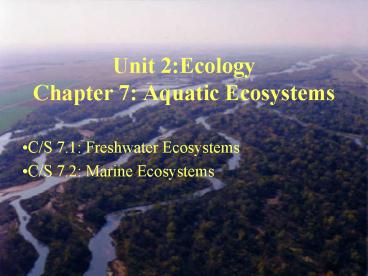Unit 2:Ecology Chapter 7: Aquatic Ecosystems - PowerPoint PPT Presentation
1 / 15
Title:
Unit 2:Ecology Chapter 7: Aquatic Ecosystems
Description:
What determines the organisms that live in an ... How much light reaches the Benthic Zone? What is a Eutrophic Lake? ... Benthic zones are nutrient rich ... – PowerPoint PPT presentation
Number of Views:179
Avg rating:3.0/5.0
Title: Unit 2:Ecology Chapter 7: Aquatic Ecosystems
1
Unit 2EcologyChapter 7 Aquatic Ecosystems
- C/S 7.1 Freshwater Ecosystems
- C/S 7.2 Marine Ecosystems
2
C/S 7.1 Freshwater Ecosystems
Characteristics of Aquatic Ecosystems
What determines the organisms that live in an
ecosystem?
Examples of Nekton include
Live attached to hard surfaces, examples are
What are the two types of Plankton?
Decomposers are also in aquatic ecosystems.
3
C/S 7.1 Freshwater Ecosystems
Lakes and Ponds
Where does photosynthesis take place?
Aquatic life is diverse and abundant in the
Littoral Zone. Where is it located?
Where do bacteria live in lakes to decompose dead
organisms?
What is a Eutrophic Lake?
How much light reaches the Benthic Zone?
What happens as the amount of plants and algae
grow in a eutrophic lake?
4
(No Transcript)
5
C/S 7.1 Freshwater Ecosystems
Freshwater Wetlands
In addition to all of the environmental functions
of wetlands they also produce commercial products
such as cranberries.
What are the two types of Freshwater Wetlands?
Draw Table 1 p175
Where do freshwater marshes tend to occur?
What are some adaptations that waterfowl and
birds have made for life in the wetlands?
Benthic zones are nutrient rich
What are the two types of marshes?
6
C/S 7.1 Freshwater Ecosystems
Freshwater Wetlands (cont)
Why have wetrlands been drained, filled and/or
cleared?
Where do swamps typically occur?
Freshwater swamps are ideal habitats what animals?
How much land did the Florida Everglades once
cover as opposed to today?
7
(No Transcript)
8
(No Transcript)
9
C/S 7.1 Freshwater Ecosystems
Rivers
Rivers typically originate from snowmelt?
At headwater area rivers are clod and well
oxygenated loose as goes downstream
What does runnoff do to a river?
As one moves further downstream what plants and
animals will you find?
The headwater area of rivers tend to hold what
plants and animals?
What are the only two states in the United States
to not have a single river flowing into them?
What are the dangers and actions to rivers?
10
C/S 7.2 Marine Ecosystems
Coastal Wetlands
Coastal wetlands are used for
Why and how are estuaries productive?
How do estuaries support marine life so well.
(food web)
What are the main pollutants of estuaries, lakes,
rivers, and oceans?
What has happened to many estuaries?
Where do salt marshes develop?
What do salt marshes support and how do they act
as a nursery?
Rocky Shores v. Sandy Shores
Mangrove swamps help protect
11
(No Transcript)
12
C/S 7.2 Marine Ecosystems
Coral Reefs
Coral polyps are
Coral reefs are among the most
Where are coral reefs found?
Why do coral reefs provide such good places to
live for fish, snails, clams, and sponges?
What do coral reefs eat and how do they catch
their prey?
How much of the worlds coral reefs are in danger?
What events/activities can and do put coral reefs
in danger dying and disappearing?
13
(No Transcript)
14
C/S 7.2 Marine Ecosystems
Oceans
Where is most ocean life found and why?
How does phytoplankton keep from sinking to the
bottom of the ocean?
The zooplankton include
The Antarctic is the only continent never
colonized.
What is the main source of food in the ocean
floor?
What are the main threats to ocean life?
Design a food chain for the Arctic and Antarctic
ecosystems (in computer lab).
15
(No Transcript)































